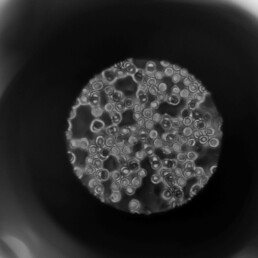Topic
Healthcare & Life Science
In 2013, EVS developed BeQuanti – a software specialized for the automatic analysis of leukocyte trafficking underflow – in collaboration with the LCTST lab at Verona University.
“Our LCTST lab collaborated in the development of BeQuanti in order to create a novel bioinformatics tool that would be useful for the leukocyte trafficking community. BeQuanti is implemented according to modern cell recognition and characterization parameters. The result is an integrated, easy-to-use, yet highly flexible bioinformatics environment that gives an automatic and comprehensive quantification of cell behavior under-flow”.
― Prof. Carlo Laudanna, MD-PhD
Verona University, LCTSTlab
Problem
Transforming Immune System Research
The effective functioning of the immune system heavily depends on the formidable leukocyte, emphasizing the crucial importance of in-depth investigations into these cells. Analyzing leukocyte recruitment at the cellular and molecular levels through in-vitro and in-vivo methodologies involves relying on extensive digital high-speed recordings of cellular events stored in videos, often requiring manual analysis. BeQuanti is a pioneering solution, designed to automatically detect and quantify cell interactions in underflow.
Immune system response regulation is mainly dependent on leukocyte function. The complex, multi-step immune response process that allows leukocytes to accumulate in tissue sites is called leukocyte recruitment and is the immune system’s primary homeostatic event. It is also the primary pathogenetic event in immunity-related diseases, such as autoimmune diseases, infectious diseases and inflammatory diseases like multiple sclerosis, rheumatoid arthritis, psoriasis and Crohn’s disease, to mention but a few.
Several advanced in-vitro and in-vivo technologies have been developed over the past years to study leukocyte recruitment at both the cellular and molecular level under experimental conditions as similar to physiological conditions as possible.
One common feature of all these experimental approaches is the chance to digitally record cellular events at high-speed, generating videos that can then be analyzed in order to collect quantitative data on cell behavior. The digital video analysis phase is what causes a bottleneck. It is usually performed manually by a highly trained person in accordance with arbitrary chosen parameters. The process is extremely time consuming, tedious, and prone to errors.
Solution
Automatically detect and quantify cell interaction
BeQuanti is a software package designed to automatically detect and quantify cell interaction in underflow. It is the instrumental solution for research laboratories working on cell trafficking for basic research and drug discovery.
Added value
Speeds up the research process
BeQuanti dramatically speeds up the research process by performing highly detailed and reliable analysis of several cell adhesion parameters.
A 30-day trial version is available free of charge both for Windows and Mac OS.
BeQuanti is modular and customizable.
Contact us for any specific requirements.
Project partner
LCTST lab – Laboratory of Cell Trafficking and Signal Transduction and the Centre for Biomedical Computing. In addition to being the first BeQuanti user, the LCTST lab was a crucial partner in its development since it provided information on the analysis methods accepted by the scientific community, data for model training and support for testing and verifying the results.
Insights
Optimal Conditions
BeQuanti has been optimized for parallel chamber underflow settings and for phase contrast microscopy, regardless of the flow direction. It is ideally suited for multiple, experimental, microfluidic underflow settings. Capillary tube-derived data can also be analyzed.
Applications
BeQuanti has been designed to assist pharmaceutical and biotechnological laboratories, universities and government research institutions in the study of cell trafficking and in particular phenomena related to leukocyte recruitment.
Examples of applications are as follows:
- Quantitative analysis of cell adhesion underflow, including the characterization of:
- selecting-mediated tethering and rolling adhesions
- integrin-mediated arrest
- post-arrest adhesion stabilization
- morphology of adherent cells
- Screening of anti-adhesive compounds
- Quantitative analysis of pro-adhesive signal transduction mechanisms
- Quantitative analysis of migration underflow
Principle of Operation
BeQuanti is based on state-of-art techniques for video analysis and machine learning. An advanced pattern recognition engine is trained to detect, track and classify cells as efficiently as the human eye in a context of continuous shape and position variation.
For further details on BeQuanti, download the tech-sheet.




